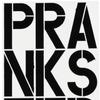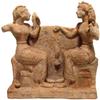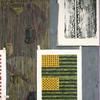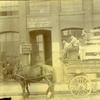First Major Exhibition of 19th-Century, Wooden Toys Made in Germany for American Buyers to Open in Late October 2016 at the Abby Aldrich Rockefeller Folk Art Museum in Williamsburg, Virginia
- WILLIAMSBURG, Virginia
- /
- September 13, 2016
In today’s world of advertising, what you see in a mail order or a sales rep’s catalogue is usually what you get. In the nineteenth century, however, ordering toys to be sold in an American store meant perusing 200-page, hardcover “catalogues” filled with hand-colored engraved images of more than 2,400 toys that were hand-crafted in Germany, the so-called Toy Center of the World. A rare example of such a catalogue from the 1840s along with approximately 50 toys from the Colonial Williamsburg collections that directly relate to it is the basis for a new exhibition, German Toys in America, which will open on October 29, 2016, at the Abby Aldrich Rockefeller Folk Art Museum, one of the Art Museums of Colonial Williamsburg. The exhibition, the first major show focused on these wooden and papier maché toys, will be on view through August 2018.
“In reading newspapers from the late 19th-century,” Jan Gilliam, Colonial Williamsburg’s associate curator of toys states, “I noticed that almost every December there were articles about the Toy Center of the World, the specific regions in Germany (primarily Thuringia, Erzgebirge and Nuremberg) where the toys were made, the families that made the toys and the German toy markets. There was a thriving cottage industry where each toy was carved by one person and painted by another; the finished toys were brought by an agent to a central location, such as Nuremburg, and assembled into play sets and shipped all around the world.”
The toys themselves—Noah’s Ark sets, soldier sets, animal squeak toys, Jumping Jacks, dolls and more—are simple but brightly colored with charming characteristics. They provided ample opportunity for a child’s imagination to bring otherwise static toys to life. Some of the toys could move, such as a small soldier on a rocking horse or a drummer in full uniform whose arms moved up and down on his drum at the turn of a small handle. These toys from the 1800s also offer a window into what delighted children of that era; by the turn of the century, tin and cast iron toys became more prevalent and wooden toys became somewhat old-fashioned.
“Colonial Williamsburg owns a spectacular collection of nineteenth-century German toys. Colorful and imaginatively detailed, they never fail the command the attention of those who see them. In this age of electronic playthings, these handmade animals, vehicles, and figures can still stir the imaginations of our visitors, both the young and the not so young” said Ronald L. Hurst, the Foundation’s Carlisle Humelsine chief curator and vice president for collections, conservation, and museums.
Among the highlights of German Toys in America is the toy sample book of the firm of Gi Mohrhard Father & Son, Nuremberg, Germany, ca. 1840. The majority of the more-than-2,400 toys represented within the rare volume were probably made in Thuringia, while others came from regions in Bavaria and Saxony, Germany. All of the toys to be displayed with it were made between 1840 and 1880. Most are made of wood or wood and papier maché; a few have paper and a few include leather (the bellow of the squeak toys). Each of the toys has a corresponding image in the catalogue, and a digital copy of the entire book will be shown so exhibition visitors can flip through all the pages. While merchants aimed to offer toys at all price points (from as little as a few cents to more than $50), the toys in German Toys in America, were on the lower end of the scale and targeted towards the middle class.
Featured in the exhibition will be a 24-inch, painted wood Noah’s Ark (the largest toy to be on view) that comes with approximately 80 pairs of animals. A staple for a child’s nursery throughout the nineteenth century, a Noah’s Ark was sometimes referred to as the “universal toy of childhood” and was available in a variety of sizes for a range of prices. Small arks came with Noah and his wife and a few pair of animals while the largest ark carried Mr. and Mrs. Noah along with all of his sons and their wives and innumerable pairs of animals from ladybugs to elephants. It was also the perfect Sunday toy: Noah and his family and animals could entertain young children while inspiring them with the famous biblical tale.
Many toys in the catalogue came as sets—after all, you can’t construct a village or manage a farm with only one building or a farmer with no animals—and individual pieces were packaged together in wooden boxes. A wood-and-paint village to be shown in German Toys in America is another highlight. Each of the 14 pieces in this set is a simple, shaped piece of wood painted a bright color and dotted with black windows. Building sets could be as small as a few buildings for a village or as large as 50 or 60 structures that form a walled city. If one set wasn’t enough, additional sets could be purchased and added on.
During the 1800s, toy soldiers were one of the popular toys for boys, and in a young boy’s mind (at least), they are probably also best in large sets as it is hard to fight a battle with only one or two. The mounted soldiers to be shown in German Toys in America are more detailed than some and are expertly painted. (Like most toys, the quality and price varied, offering options to the consumer. This set would have been considered high quality and likely more expensive.) Since Germany shipped toys all over the world, many uniforms were represented. Some seemed to be based on actual armies while others were more general. Newspapers reported wars from around the world and featured engravings of armies in battle so boys recognized uniforms and countries and could recreate their own version of events.
Another popular toy of the period was the squeak or bellow toy. The duck featured in the exhibition also represents the popularity of animal toys, which have natural appeal for children to this day. While the shelves of toy shops were filled with sets of wooden animals, representing the wild beasts of a jungle or the mild mannered creatures of the farm, large individual animals were mounted on wheels or on bellows. These bellows toys were charming in that the animals could “talk.” When a child pressed on the bellows, the creature seemed to speak. (In reality, many sounded just alike and emitted a one-note squeak.” Some, like this duck, also incorporated movement: as the sound came out, the duck’s wings flapped.
German Toys in America was generously funded by Don and Elaine Bogus.
For children of all ages, anyone who appreciates hand-made toys, those who are fascinated by period cottage industries and their economics and visitors who simply take pleasure in the memories of childhoods past spent playing with a favorite toy, German Toys in America is an exhibition to be cherished.
About The Art Museums of Colonial Williamsburg
The Art Museums of Colonial Williamsburg include the Abby Aldrich Rockefeller Folk Art Museum and the
DeWitt Wallace Decorative Arts Museum. The Abby Aldrich Rockefeller Folk Art Museum is home to the nation’s premier collection of American folk art, with more than 5,000 folk art objects made during the 18th, 19th and 20th centuries. The DeWitt Wallace Decorative Arts Museum exhibits the best in British and American decorative arts from 1670–1830. The Art Museums of Colonial Williamsburg are located at the intersection of Francis and South Henry Streets in Williamsburg, Va., and are entered through the Public Hospital of 1773. Museum hours from March 18, 2016, to January 2, 2017, 10:00 a.m. to-7:00 p.m. daily. For museum program information, telephone (757) 220-7724.
About The Colonial Williamsburg Foundation
The Colonial Williamsburg Foundation preserves, restores and operates Virginia’s 18th-century capital of Williamsburg. Innovative and interactive highlight the relevance of the American Revolution to contemporary life and the importance of an informed, active citizenry. The Colonial Williamsburg experience includes more than 400 restored or reconstructed original buildings, renowned museums of decorative arts and folk art, extensive educational outreach programs for students and teachers, lodging, culinary options from historic taverns to casual or elegant dining, the Golden Horseshoe Golf Club featuring 45 holes designed by Robert Trent Jones and his son Rees Jones, a full-service spa and fitness center, pools, retail stores and gardens. Philanthropic support and revenue from admissions, products and hospitality operations sustain Colonial Williamsburg’s educational programs and preservation initiatives.
# # #
Contact:
Robyn LiverantRobyn Liverant Public Relations
robyn@robynliverant.com


270x400_c.jpg)





100x100_n.jpg)













